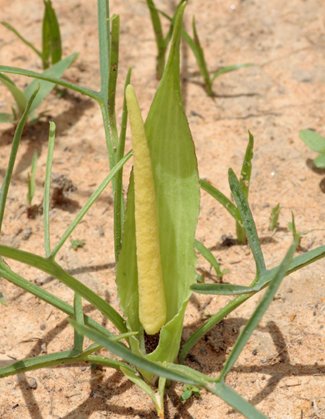New lily species smells like burnt electrics

A NEW SPECIES OF desert lily that smells like a burnt-out electrical motor has been discovered in Western Australia’s Kimberley region.
Conservation geneticist Dr Matthew Barrett of Kings Park and Botanic Garden, in Perth, discovered the new native near Kununurra and has dubbed it “nano-arum” (Typhonium spp) because of its small size. At between five and ten centimetres tall, it is half the size of the average arum lily and is among the world’s smallest.
Based on his previous research of other arum species, Matthew says the unusual perfume is likely volatile chemical amines released by the plant. “The burnt-out electrics smell is the plant trying to attract a specific type of pollinator beetle, called the rove beetle,” he says.
Some of the new plants were found with the beetles still inside the flower. He says the size and elongated abdomen of the rove beetle make it better equipped to pollinate the trumpet-shaped flower of the nano-arum.
Putrid attraction
Some Australian arum lilies attract pollinators such as dung beetles by looking or smelling like rotting meat or dung which is mimicked in their dark red colouring. The new arum lily is unusual in that it is green. Matthew says the different colour has something to do with the rove beetle pollinators and their attraction to rotting plant matter.
Matthew was surveying the area for a different species when he came upon the nano-arum and says the discovery of new species is not such a rare thing. “It’s not unusual for us to find one new species per day on wet season trips,” he says.
The discovery showed how many more plants were still to be discovered in Western Australia’s north, he says, particularly those like the nano-arum, which flowers for only two days in the wet season.
The environment minister of Western Australia, Bill Marmion, says that it is unusual to find a new species so close to a major town.
RELATED STORIES

